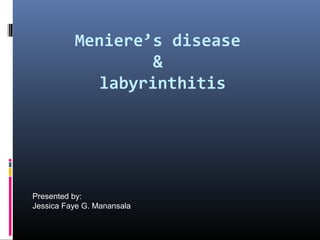
meniere's disease (Vertigo) and labyrinthitis
- 1. Meniere’s disease & labyrinthitis Presented by: Jessica Faye G. Manansala
- 2. Anatomy of the inner ear The inner ear is house deep within the temporal bone. The organs of hearing (cochlea) and balance (semicircular canals), as well as the cranial nerves VII (facial nerve) and VIII (vestibulocochlear nerve) Cochlea and semicircular canals – are housed in the bony of labyrinth. Bony labyrinth – surrounds and protect the membranous labyrinth, which is bathed in a fluid called perilymph
- 3. Membranous labyrinth – it contains a fluid called endolymph(posterior,superior , inferior & lateral). - Contains sensory receptor organs, arrange to detect rotational movement. - These receptor end organs are stimulated by changes in the rate or direction of an individual movement.
- 4. Organ of orti Snale shape bony tube about 3.5 cm long with 2 and one half spiral turns The organ of orti called the end organ of hearing, transform mechanical energy into neural activity and seperates sound into diff frequencies. This electrochemical impulse travels through the acoustic nerve to the temporal cortex of the brain.
- 7. Vertigo Vertigo is defined as misperception or illusion of motion of the person or the surroundings. Most person with vertigo describe a spinning sensation or say they feel as though objects are moving around them Signs and symptoms Nausea or vomiting Sweating and/or Abnormal eye movements.
- 9. Meniere’s disease Meniere’s disease is an abnormal inner ear fluid balance caused by malabsorption in the endolymphatic sac People with meniere’s disease may have blockage in the endolymphatic duct. Cause Increase pressure in the system or rupture of the inner ear membranes that producing meniere’s symptoms.
- 10. Clinical manifestations Fluctuating Progressive sensorineural hearing loss Tinnitus Feeling of pressure or fullness in the ear Episodic Incapsulating vertigo with nausea and vomiting
- 11. 2 subsets of Meniere’s Disease 1. Cochlear Meniere’s Disease Is recognized as fluctuating, progressive sensory neural hearingloss, tinnitus and aural pressure. 2. Vestibular Meniere’s Disease Occurrence of episodic vertigo associate with aural pressure but no cochlear symptoms.
- 12. Normal labyrinth Dilated labyrinth
- 13. Diagnostic test Weber test- sound from a tuning fork (may lateralize to the ear opposite the hearing loss, the one affected with meniere’s disease) Audiogram – reveals a sensorineural hearing loss in the affected ear. In the form of “Pike’s Peak” pattern.
- 14. Medical management Low sodium diet – sodium and fluid retention disrupts the delicate balance btw endolymph and perilymph in the inner ear. Pharmacologic theraphy Antihistamine meclizane (antivert) – supresses the vestibular system Tranquilizer (diapezam) valium – used acute instances to help control vertigo. Antiemetic (promethazine/phenergan) – suppositories help control nausea and vomiting and vertigo because of antihistamine effect. Diuretic theraphy (hydrochlorothiazide) – reduce symptoms by lowering the pressure in the endolymphatic system.
- 15. Surgical management Endolymphatic sac decompression (shunting) – equalizes the pressure in the endolyphatic space - A shunt or drain is inserted ion the endolymphatic sac through a postauricular incision. middle ear perfusion – ototoxic medication (streptomycin or gentamicin) can be given to pt. by infusion into the middle and inner ear. -this meds used to decrease vestibular function and decrease vertigo. It requires overnight stay because imbalance that last several weeks. Intraotologic catheter- to provide a conduit from the outer ear to the inner ear. It is used to treat sudden hearing loss and various disorder causing intractable vertigo. Vestibular nerve section
- 17. labyrinthistis Inflammation of the inner ear can be bacterial or viral in origin. Infection can enter the inner ear by penetrating the membranes of the oval or round windows (membrane). Cause of labyrinthitis are viral diseases like: mumps Rubella Rubeola influenza
- 18. Clinical manifestations Sudden incapacitating vertigo Nausea and vomiting Various degrees of hearing loss Possible tinnitus Management Bacterial - IV antibiotic theraphy, fluid replacement and administration of vestibular suppresant (meclizine and antiemetic).
- 20. The end!